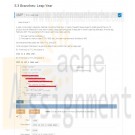Search results for 'Chapter 5: Apply Your Knowledge – Adding Fields, Using Input Mask and Querying Dates (Pages 327 - 328) Use the Babbage CPA'
Maximum words count is 10. In your search query was cut next part: Mask and Querying Dates (Pages 327 - 328) Use the Babbage CPA.
-

DAT/305 Week 3 Challenge Activities 3.4.1: Queues using linked lists
Regular Price: $5.00
Special Price $2.00
DAT/305 Week 3 Challenge Activities 3.4.1: Queues using linked lists
CHALLENGE ACTIVITY 1
Given an empty queue numQueue, what does the list head pointer point to? If the pointer is null, enter null.
What does the list tail pointer point to?
After the following operations:
QueueEnqueue(numqueue, 66)
QueueEnqueue(numQueue, 93)
QueueDequeue(numQueue)What does the list head pointer point to?
What does the list tail pointer point to?
CHALLENGE ACTIVITY 2Given numQueue: 78, 37, 47
What does the list head pointer point to? If the pointer is null enter null.
What does the list tail pointer point to?
After the following operations:
QueueEnqueue(numQueue, 60)
QueueEnqueue(numqueue, 57)
QueueDequeue(numQueue)
QueueDequeue(numQueue)What does the list head pointer point to?
What does the list tail pointer point to?
Learn More -

DAT/305 Week 3 Challenge Activities 3.2.1: Stacks using linked lists
Regular Price: $5.00
Special Price $3.00
DAT/305 Week 3 Challenge Activities 3.2.1: Stacks using linked lists
CHALLENGE ACTIVITY 1
Given an empty stack numStack, what does the list head pointer point to? If the pointer is null, enter null.
After the following operation, which node does the list head pointer point to?
StackPush(numStack, 83)
CHALLENGE ACTIVITY 2Given numStack: 54, 38, 25, 28 (top is 54)
After the following operation: StackPush(numStack, 40)
What node does newNode's next pointer point to? If the pointer is null, enter null.What node does the list's head pointer point to?
CHALLENGE ACTIVITY 3Given numStack: 51 (top is 51)
After the following operation: StackPop(numStack)
What is returned?What node does the list's head pointer point to? If the pointer is null, enter null:
Learn More -

DAT/380 Week 5 LAB 5.7 - Implement supertype and subtype entities (Sakila)
Regular Price: $5.00
Special Price $3.00
DAT/380 Week 5 LAB 5.7 - Implement supertype and subtype entities (Sakila)
Refer to the customer and staff tables of the Sakila database. These tables have many columns in common and represent similar entities. Convert the customer and staff entities into subtypes of a new supertype person:
In the center is the person entity, with primary key person_id and additional attributes first_name, last_name, email, active, and last_update. The person entity contains subtype entities staff and customer. The staff entity has primary key person_id and additional attributes picture, username, and password. The customer entity has primary key person_id and additional attribute create_date. Cardinality does not appear after the primary keys and attributes. On the left is the address entity, connected to the person entity by the belongs_to relationship. Belongs_to has cardinality 1(1) on the address side and M(0) on the person side. On the right is the store entity, connected to the person entity by the works_at relationship. Works_at has cardinality 1(1) on the store side and M(0) on the person side.
The diagram uses Sakila naming conventions. Follow the Sakila conventions for your table and column names:
All lower case
Underscore separator between root and suffix
Foreign keys have the same name as referenced primary keyImplement supertype and subtype entities as person, customer, and staff tables with primary key person_id.
Implement attributes as columns:
All columns are NOT NULL.
The person_id columns have data type SMALLINT UNSIGNED.
The last_update and create_date columns have data type TIMESTAMP.
The picture column has data type BLOB.
All other columns have data type VARCHAR(20).Implement the dependency relationships between subtype and supertype entities as foreign keys:
The person_id columns of customer and staff become foreign keys referring to person.
Specify CASCADE actions for both relationships.Implement the belongs_to and works_at relationships as foreign keys:
belongs_to becomes an address_id foreign key in person referring to address.
works_at becomes a store_id foreign key in staff referring to store.
Specify RESTRICT actions for both relationships.The address and store tables, with primary keys address_id and store_id, are pre-defined in the zyLab environment. Foreign keys must have the same data types as the referenced primary keys:
address_id has data type SMALLINT UNSIGNED.
store_id has data type TINYINT UNSIGNED.If you execute your solution with the Sakila database, you must first drop customer, staff, and all constraints that refer to these tables. Use the following statements with Sakila only, not in the zyLab environment:
Learn More
DROP TABLE customer, staff;
ALTER TABLE payment
DROP CONSTRAINT fk_payment_customer,
DROP CONSTRAINT fk_payment_staff;
ALTER TABLE rental
DROP CONSTRAINT fk_rental_customer,
DROP CONSTRAINT fk_rental_staff;
ALTER TABLE store
DROP CONSTRAINT fk_store_staff; -

DAT/380 Week 5 LAB 5.6 - Implement independent entity (Sakila)
Regular Price: $5.00
Special Price $3.00
DAT/380 Week 5 LAB 5.6 - Implement independent entity (Sakila)
Implement a new independent entity phone in the Sakila database. Attributes and relationships are shown in the following diagram:
The phone entity appears on the right. The phone entity contains four attributes, each followed by cardinality information: phone_id 1-1(1), country_code M-1(1), phone_numer M-1(1), and phone_type M-1(0). Three entities appear on the left: store, staff, and customer, connected to the phone entity by three identical relationships. The three relationships are named 'has' and have cardinality 1(0) on both sides.
The diagram uses Sakila naming conventions. Follow the Sakila conventions for your table and column names:
All lower case
Underscore separator between root and suffix
Foreign keys have the same name as referenced primary keyWrite CREATE TABLE and ALTER TABLE statements that:
1. Implement the entity as a new phone table.
2. Implement the has relationships as foreign keys in the Sakila customer, staff, and store tables.
3. Remove the existing phone column from the Sakila address table.Step 2 requires adding a foreign key constraint to an existing table. Ex:
ALTER TABLE customer
ADD FOREIGN KEY (phone_id) REFERENCES phone(phone_id)
ON DELETE SET NULL
ON UPDATE CASCADE;
Specify data types as follows:
phone_id, phone_number, and country_code have data type INT.
phone_type has date type VARCHAR(12) and contains strings like 'Home', 'Mobile', and 'Other'.Apply these constraints:
Learn More
NOT NULL constraints correspond to cardinalities on the diagram above.
Foreign key actions are SET NULL for delete rules and CASCADE for update rules.
Specify a suitable column as the phone table primary key. -

DAT/380 Week 3 LAB 3.12 - Create LessonSchedule table with FK constraints
Regular Price: $5.00
Special Price $3.00
DAT/380 Week 3 LAB 3.12 - Create LessonSchedule table with FK constraints
Two tables are created:
Horse with columns:
ID - integer, primary key
RegisteredName - variable-length stringStudent with columns:
ID - integer, primary key
FirstName - variable-length string
LastName - variable-length stringCreate the LessonSchedule table with columns:
HorseID - integer with range 0 to 65 thousand, not NULL, partial primary key, foreign key references Horse(ID)
StudentID - integer with range 0 to 65 thousand, foreign key references Student(ID)
LessonDateTime - date/time, not NULL, partial primary keyIf a row is deleted from Horse, the rows with the same horse ID should be deleted from LessonSchedule automatically.
If a row is deleted from Student, the same student IDs should be set to NULL in LessonSchedule automatically.
Note: Table and column names are case sensitive in the auto-grader.
CREATE TABLE Horse (
ID SMALLINT UNSIGNED AUTO_INCREMENT,
RegisteredName VARCHAR(15),
PRIMARY KEY (ID)
);CREATE TABLE Student (
ID SMALLINT UNSIGNED AUTO_INCREMENT,
FirstName VARCHAR(20),
LastName VARCHAR(30),
PRIMARY KEY (ID)
);-- Your SQL statements go here
Learn More -

DAT/380 Week 2 LAB 2.10 - Select employees and managers with inner join
Regular Price: $5.00
Special Price $3.00
DAT/380 Week 2 LAB 2.10 - Select employees and managers with inner join
The Employee table has the following columns:
ID - integer, primary key
FirstName - variable-length string
LastName - variable-length string
ManagerID - integer
Write a SELECT statement to show a list of all employees' first names and their managers' first names. List only employees that have a manager. Order the results by Employee first name. Use aliases to give the result columns distinctly different names, like "Employee" and "Manager".Hint: Join the Employee table to itself using INNER JOIN.
Learn More -

PRG 211 Week 5 Labs
Regular Price: $20.00
Special Price $15.00
PRG 211 Week 5 Labs
Lab 11.1 Miles to track laps
One lap around a standard high-school running track is exactly 0.25 miles. Write a program that takes a number of miles as input, and outputs the number of laps.
Ex: If the input is 1.5, the output is:
6.0Ex: If the input is 2.2, the output is:
8.8Your program should define and call a function:
Function MilesToLaps(float userMiles) returns float userLaps
Lab 11.2 Driving costWrite a function DrivingCost with parameters drivenMiles, milesPerGallon, and dollarsPerGallon, that returns the dollar cost to drive those miles. All items are of type float.
Ex: If the function is called with 50 20.0 3.1599, the function returns 7.89975.
Define that function in a program whose inputs are the car's miles/gallon and the gas dollars/gallon (both floats). Output the gas cost for 10 miles, 50 miles, and 400 miles, by calling your DrivingCost function three times.
Ex: If the input is 20.0 3.1599, the output is:
1.57995 7.89975 63.198Note: Small expression differences can yield small floating-point output differences due to computer rounding. Ex: (a + b)/3.0 is the same as a/3.0 + b/3.0 but output may differ slightly. Because our system tests programs by comparing output, please obey the following when writing your expression for this problem. In the DrivingCost function, use the variables in the following order to calculate the cost: drivenMiles, milesPerGallon, dollarsPerGallon.
Lab 11.3 Step counterA pedometer treats walking 2,000 steps as walking 1 mile. Write a program whose input is the number of steps, and whose output is the miles walked. If the input is 5345, the output is 2.6725.
Your program should define and call a function:
Function StepsToMiles(integer userSteps) returns float numMiles
Lab 11.4 Leap yearA year in the modern Gregorian Calendar consists of 365 days. In reality, the earth takes longer to rotate around the sun. To account for the difference in time, every 4 years, a leap year takes place. A leap year is when a year has 366 days: An extra day, February 29th. The requirements for a given year to be a leap year are:
1) The year must be divisible by 4
2) If the year is a century year (1700, 1800, etc.), the year must be evenly divisible by 400
Some example leap years are 1600, 1712, and 2016.
Write a program that takes in a year and determines whether that year is a leap year. If the input is 1712, the output is: 1712 is a leap year. If the input is 1913, the output is: 1913 is not a leap year.
Your program must define and call a function:
Function OutputLeapYear(integer inputYear) returns nothing
The function should output whether the input year is a leap year or not.
Lab 11.5 Max and min numbersWrite a program whose inputs are three integers, and whose outputs are the largest of the three values and the smallest of the three values. If the input is 7 15 3, the output is:
largest: 15
smallest: 3Your program should define and call two functions:
Function LargestNumber(integer num1, integer num2, integer num3) returns integer largestNum
Function SmallestNumber(integer num1, integer num2, integer num3) returns integer smallestNum
The function LargestNumber should return the largest number of the three input values. The function SmallestNumber should return the smallest number of the three input values.
Lab 11.6 Output values below an amountWrite a program that first gets a list of six integers from input. The first five values are the integer list. The last value is the upper threshold. Then output all integers less than or equal to the threshold value.
Ex: If the input is 50 60 140 200 75 100, the output is:
50 60 75
For coding simplicity, follow every output value by a space, including the last one.Such functionality is common on sites like Amazon, where a user can filter results.
Your program should define and use a function:
Learn More
Function outputIntsLessThanOrEqualToThreshold(integer array(?) userVals, integer upperThreshold) returns nothing -

PRG 211 Week 4 Labs
Regular Price: $12.00
Special Price $9.00
PRG 211 Week 4 Labs
Lab 9.1 Output numbers in reverse
Write a program that reads a list of 10 integers, and outputs those integers in reverse. For coding simplicity, follow each output integer by a space, including the last one. Then, output a newline.
Ex: If the input is 2 4 6 8 10 12 14 16 18 20, the output is:
20 18 16 14 12 10 8 6 4 2
To achieve the above, first read the integers into an array. Then output the array in reverse.
Lab 9.2 Middle itemGiven a sorted list of integers, output the middle integer. Assume the number of integers is always odd.
Ex: If the input is 2 3 4 8 11 -1 (a negative indicates end), the output is:
4
The maximum number of inputs for any test case should not exceed 9. If exceeded, output "Too many inputs".Hint: Use an array of size 9. First read the data into an array. Then, based on the number of items, find the middle item.
Lab 9.3 Output values below an amountWrite a program that first gets a list of 5 integers from input. Then, get another value from the input, and output all integers less than or equal to that value.
Ex: If the input is 50 60 140 200 75 100, the output is:
50 60 75
For coding simplicity, follow every output value by a space, including the last one. Then, output a newline.Such functionality is common on sites like Amazon, where a user can filter results.
Learn More -

PRG 211 Week 3 Labs
Regular Price: $15.00
Special Price $12.00
PRG 211 Week 3 Labs
Lab 7.1 Loops Convert to binary
Write a program that takes in a positive integer as input, and outputs a string of 1's and 0's representing the integer in binary. For an integer x, the algorithm is:
As long as x is greater than 0
Output x % 2 (remainder is either 0 or 1)
x = x / 2
Note: The above algorithm outputs the 0's and 1's in reverse order.Ex: If the input is 6, the output is:
011
(6 in binary is 110; the algorithm outputs the bits in reverse).
Lab 7.2 Loops Varied amount of input dataStatistics are often calculated with varying amounts of input data. Write a program that takes any number of non-negative integers as input, and outputs the average and max. A negative integer ends the input and is not included in the statistics.
Ex: When the input is 15 20 0 5 -1, the output is:
10 20
You can assume that at least one non-negative integer is input.
Lab 7.3 Loops Output range with increment of 10Write a program whose input is two integers, and whose output is the first integer and subsequent increments of 10 as long as the value is less than or equal to the second integer.
Ex: If the input is -15 30, the output is:
-15 -5 5 15 25Ex: If the second integer is less than the first as in 20 5, the output is:
Second integer can't be less than the first.For coding simplicity, output a space after every integer, including the last.
Lab 7.4 Loops Countdown until matching digitsWrite a program that takes in an integer in the range 20-98 as input. The output is a countdown starting from the integer, and stopping when both output digits are identical.
Ex: If the input is 93, the output is:
93 92 91 90 89 88Ex: If the input is 77, the output is:
77Ex: If the input is not between 20 and 98 (inclusive), the output is:
Input must be 20-98For coding simplicity, follow each output number by a space, even the last one. Use a while loop. Compare the digits; do not write a large if-else for all possible same-digit numbers (11, 22, 33, ..., 88), as that approach would be cumbersome for large ranges.
Learn More -

PRG 211 Week 2 Labs
Regular Price: $12.00
Special Price $9.00
Lab 5.1 Largest number
Write a program whose inputs are three integers, and whose output is the largest of the three values.
Ex: If the input is 7 15 3, the output is:
15
Lab 5.2 Remove gray from RGBSummary: Given integer values for red, green, and blue, subtract the gray from each value.
Computers represent color by combining the sub-colors red, green, and blue (rgb). Each sub-color's value can range from 0 to 255. Thus (255, 0, 0) is bright red, (130, 0, 130) is a medium purple, (0, 0, 0) is black, (255, 255, 255) is white, and (40, 40, 40) is a dark gray. (130, 50, 130) is a faded purple, due to the (50, 50, 50) gray part. (In other words, equal amounts of red, green, blue yield gray).
Given values for red, green, and blue, remove the gray part.
Ex: If the input is 130 50 130, the output is:
80 0 80
Find the smallest value, and then subtract it from all three values, thus removing the gray.Note: This page converts rgb values into colors.
Lab 5.3 Leap YearA year in the modern Gregorian Calendar consists of 365 days. In reality, the earth takes longer to rotate around the sun. To account for the difference in time, every 4 years, a leap year takes place. A leap year is when a year has 366 days: An extra day, February 29th. The requirements for a given year to be a leap year are:
1. The year must be divisible by 4
2. If the year is a century year (1700, 1800, etc.), the year must be evenly divisible by 400
Some example leap years are 1600, 1712, and 2016.Write a program that takes in a year and determines whether that year is a leap year.
Ex: If the input is 1712, the output is:
1712 is a leap year.Ex: If the input is 1913, the output is:
Learn More
1913 is not a leap year.




